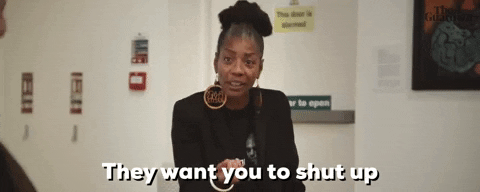Why is it so difficult for schools to make transformative racial justice change?
I have wondered about this question for many years.
We are familiar with all of the usual suspects such as resistance from people who want to keep the racial status quo in place to misalignment across the organization.
However—after having worked in education for over fifteen years and interviewed hundreds of people working in schools as well as helped to train many school leaders—they don’t adequately name the insidious reality that undermines justice work in all types of organizations, which is organizational gaslighting.
You may be thinking . . .

What is Gaslighting?
One of the first times that the term gaslighting was used was in George Cukor’s 1944 movie title Gaslighting (which is based on the 1938 play by Patrick Hamilton). In the film, Greg manipulates his wife/partner, Paula, and tries to make her think she is insane. Greg does this by isolating, confusing, and making Paula accept his imposed reality as her truth.
Over the years, the term gaslighting has made its way into popular culture and academic literature. Gaslighting is commonly understood as a type of psychological abuse that makes “victims” feel crazy and guilty for the abuse done to them.
Yet, gaslighting is still often considered an individual phenomenon that happens interpersonally between two or a few people.
However, gaslighting is deeply embedded into organizations’ socialization mechanisms, cultural norms, and everyday practices and policies. Organizational gaslighting aims to make you feel isolated, alone, and like “the only one.” It can keep people silent about their experiences of being gaslit and engender the conditions for other people to suffer in silence, lest it happen to them.

"However, gaslighting is not just individual but it's deeply embedded into organizations’ socialization mechanisms, cultural norms, and everyday practices and policies."
What is Organizational Gaslighting?
Dr. Christine Williams writes about organizational gaslighting in the context of the oil and gas industries and how it impacts women scientists.
However, it also applies to school districts and schools (i.e., education institutions) and helps us understand race and racism and its intersection with other positionalities.
Therefore, I define organizational gaslighting as: the organizational manipulation and hypocrisy that seeks to get people from (racially) minoritized communities to discredit, discount, and transform the reality of their lived experiences and intuitions into fabrications.
An intention of organizational gaslighting is to separate you from your truth, lived experiences, community, and mainly, from disrupting the organization. All the while, this separation is intended to keep you at bay so that organization can remain the same.
Here are 4 ways that I maintain that organizational gaslighting can show up.
"I define organizational gaslighting as: the organizational manipulation and hypocrisy that seeks to get people from (racially) minoritized communities to discredit, discount, and transform the reality of their lived experiences and intuitions into fabrications."
#1 Critique is Turned into Confusion and Craziness
Have you ever known or felt that something in your organization is not right? Even though you can’t put your finger on what that “something” is? You know this regardless of what people are saying and/or are showing you.
Or, have you ever experienced something overtly inequitable in an organization and you call it out. And everyone works like crazy to convince you that you’re wrong or that you misunderstood something.
You’re left feeling confused and wondering, if you’re “trippin” (or crazy). For example, it could be the mistreatment of a particular group of students in a school such as Black girls or a decision that was made which goes against the values that the organization claims to support.
"One way to know that organizational gaslighting is going on is that during unjust incidents the districts and schools will work harder to protect those who inflict harm or the organization's reputation rather than work to redress the harm that the person who was inflicted experienced."
Either way, when you ask a question about these types of incidents or even “normal” organizational conditions, you are met with a barrage of responses that aim to justify the injustice. The interesting part is that you’re often met with responses that seem logical and empathetic; you think people are really listening to you. It’s like people know all the right things to say, all of the promises to make (that go unfulfilled), and the perfect, calming tones to use.
Additionally, organization gaslighting can take on the form of protecting those in the organization who inflict harm on, specifically, people from minoritized communities. One way to know that organizational gaslighting is going on is that during unjust incidents the districts and schools will work harder to protect those who inflict harm or the organization’s reputation rather than work to redress the harm that the person who was inflicted experienced.
#2 Hiring Black, Brown, and Indigenous People in Positions of Power Who Continue White Supremacy Ideologies
Alright, here we go . . .

It’s not enough to just hire more Black people in a school district. I know this seems like heresy but let me explain.
Hiring more Black people and People of Color in your organization can totally be a good thing. However, to only hire more Black people and not change the culture, organizational norms, policies or practices just adds more Black people into a school system of white supremacy.
One of the ways that organizational gaslighting takes place is when institutions hire Black, Brown and Indigenous people into positions of power, but those people maintain the racial status quo of white supremacy because they are people who won’t call out the institution and work to make substantive transformations in the organization.
"To only hire more Black people and not change the culture, organizational norms, policies or practices just adds more Black people into a school system of white supremacy."
Another way that organizational gaslighting takes place is when school districts actually hire Black, Brown and Indigenous people who are committed to making deep and radical change. However, that person or group of people are constrained from actually doing anything because they are met with resistance, pushback, and status quo logic, at every turn.
The reality is the same in both cases: the organization can gaslight people because they can point to the fact that they hired more People of Color. However, those people are not able to do any real structural change. As a result, people in the organization will say things such as,
“What else do you want?”
“You’ve asked for a Black person and that’s who we’ve hired.”
They will say these and other things which the organization will point to as “progress.” This type of organizational gaslighting will also work to make you doubt whether or not you’re crazy or if you’re asking for too much change.
#3 Justice Talk but Unjust Practices
This form of organizational gaslighting shows up when organizations talk, write, and proclaim agendas of equity, social justice, anti-racism and even liberation. Yet, these ideas are nothing more than talk because they fail to translate into any real, material, and substantive realities.
Over the last several years, equity and anti-racism work has become more in vogue for school districts to align themselves with, at least in name.
Here’s the thing. It’s easy to talk about racial justice and liberation, but much more difficult to do what is necessary to make them realities in schools. But the question is will districts, schools, universities and other organizations actually dismantle nearly everything it knows and rebuild differently? This is often what is required to create a more racially just and equitable district

The gaslighting comes in when minoritized people try to hold the organization accountable to what it says it’s about only to find people in the organization have a million ways to excuse the chasm between what they espouse and practice.
As a result, those who have been gaslit are left feeling like “am I tripping or did we not say that this was an organization focused on justice and anti-racism?”
"It’s easy to talk about racial justice and liberation, but much more difficult to do what is necessary to make them realities in schools. But the question is will districts dismantle nearly everything it knows and rebuild differently?"
#4 Racially Diverse and Anti-Black At The Same Time
Schools (and all other organizations) can be both racially diverse and anti-Black…all at the same time. In fact, anti-blackness can thrive in racially diverse spaces. Just because your school district is racially diverse does not mean that it doesn’t treat Black people as non-human.
This is such a hard reality to get across to people.
It is difficult to do so because, again, people will, by default, point to the district’s racial diversity as a metric for progress. And while racial diversity is important and should be deeply appreciated, racial diversity and Black people are not the same.
White supremacy institutions are built on the backs of Black people and thrive on keeping us on the bottom. And having more racial diversity does not automatically change that reality. In fact, more racial diversity in organizations might make it harder for people to embrace this truth.
In closing About Gaslighting
Organizational gaslighting can impact you in many different ways. You can get sucked into the organization’s culture and norms. Or, you can figure out ways to do “your work” that pursue larger structural changes.
In sum, here are four questions to assess whether or not you’re in a context that practices organizational gaslighting.
- Does the organization work harder to protect its reputation and/or the people who inflict harm instead of those who’ve experienced harm?
- Does the organization hire Black, Brown, and Indigenous Peoples into the positions of power who perpetuate the organizational status quo?
- Does the organization try to discredit, discount, and transform any critiques against the organization into making the person(s) seem like they don’t know what they are talking about or the event as an outlier?
- Does the organization pride itself on being racially diverse yet fail to address anti-blackness in real substantive ways?
If you answered yes to these questions, then you’re likely being organizationally lit.
If this resonates at all, please let me know in the comments. And if you have ideas about other ways that organizational gaslighting shows up in the struggle for racial justice, please share in the comments.
I am deeply thankful to Dr. Shameka Powell, M. Yvonne Taylor, and Dr. Decoteau Irby for their generative comments on earlier drafts.